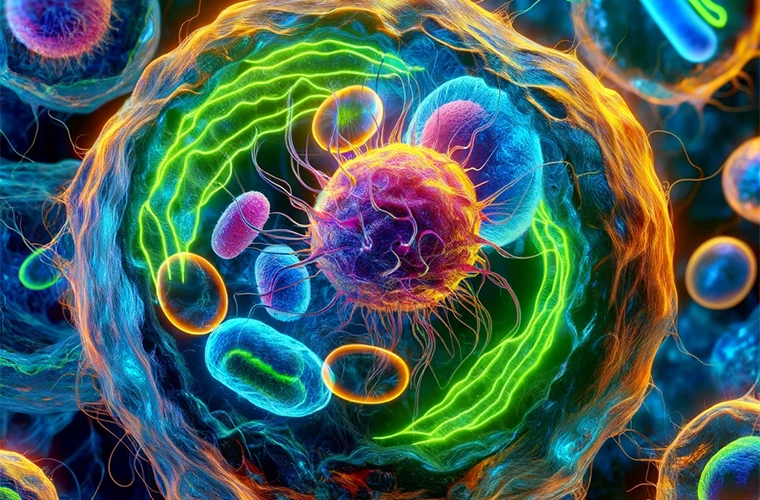Researchers from Moffitt Cancer Center have unveiled a revolutionary new discovery in cellular mechanics, suggesting that cells possess a hidden non-genomic system that facilitates rapid cellular communication and decision-making independent of DNA.
Published in iScience, this revelation challenges the DNA-centric view of cellular function and opens new avenues for medical and scientific exploration.
The conventional view in biology has always positioned DNA as the central blueprint of cellular function, dictating everything from protein synthesis to cellular behavior. However, the recent findings by Moffitt researchers introduce a different narrative, suggesting an intricate parallel communication network within cells operates alongside and beyond the genetic framework.
The study centers on the role of ion gradients, or differences in ion concentrations across the cell membranes, which consume significant energy to maintain. These gradients create electrical potentials that act as reservoirs of information, allowing cells to monitor their surroundings continuously.
When stimulated by environmental cues, specialized gates within ion channels open, permitting ion flux. This flux initiates a cascade of reactions near the membrane, helping the cell to quickly interpret and respond to new information.
Researchers say they now believe these gradients are not just biochemical necessities but are integral to a sophisticated information processing system that allows cells to quickly sense and respond to environmental changes.
This fast-acting system hinges on the flow of ions such as sodium, potassium, and calcium through specialized channels in the cell membrane. These channels open in response to external signals, allowing ions to flow into or out of the cell, creating a ripple effect that rapidly communicates the signal inward, prompting swift cellular responses.
One of the more interesting aspects of the research was the focus on the cytoskeleton, or structural framework within cells.
Traditionally recognized for maintaining cell shape and facilitating movement, the cytoskeleton appears to play a crucial role in this sophisticated non-genomic system.
Composed of microtubules and microfilaments, researchers found that proteins from the cytoskeleton serve as an excellent ion conductor. This capability allows it to function like a circuit board, directing signals from the cell membrane to various organelles within the cell, including the mitochondria and the nucleus, to ensure a coordinated response.
Researchers suggest that this sophisticated non-genomic system allows cells to react to changes in their environment with a precision and speed that the genomic information provided by DNA might be too slow to address.
“Our research reveals the capability of cells to harness transmembrane ion gradients as a means of communication, allowing them to sense and respond to changes in their surroundings rapidly,” Dr. Dipesh Niraula, Ph.D., an applied research scientist in the Department of Machine Learning and study co-author, explained. This intricate network enables cells to make swift and informed decisions, critical for their survival and function.”
The implications of this discovery are profound. Understanding this system could revolutionize disease treatment. By targeting the components of this ionic communication system, new therapies might more effectively correct the miscommunications that lead to disease development. This research also suggests that disruptions in this non-genomic communication system could play a critical role in the development of diseases like cancer, opening new avenues for medical exploration.
Moreover, the research suggests that disruptions in this non-genomic communication system could play a critical role in the development of diseases like cancer.
The study is also significant for its potential to reshape our fundamental understanding of multicellular life, a prospect that is both inspiring and intriguing. Cells within an organism rely on communication to coordinate actions and maintain tissue health. These recent findings suggest another layer of interaction, broadening our understanding of how cells function within the larger context of tissue and organ systems.
Additionally, the researchers propose that the well-studied ion fluxes observed in neurons are actually a specialized instance of this broader communication network. This could mean rethinking some of our knowledge about neurological processes and finding new angles to approach neurological disorders.
Researchers confirmed that their model aligns with various experimental findings and identified several predictions that can be tested through future studies. The hope is that these new findings will set the stage for upcoming experiments to validate this novel theory and further illuminate the complexities of how cells make decisions.
“This study challenges the implicit assumption in biology that the genome is the sole source of information and that the nucleus acts as a kind of central processor,” study co-author and research scientist at the Moffitt Cancer Biology & Evolution Program, Dr. Robert Gatenby, said in a statement.
“We present an entirely new network of information that allows rapid adaptation and sophisticated communication necessary for cell survival and probably deeply involved in the intercellular signaling that permits functioning multicellular organisms.”
Tim McMillan is a retired law enforcement executive, investigative reporter and co-founder of The Debrief. His writing typically focuses on defense, national security, the Intelligence Community and topics related to psychology. You can follow Tim on Twitter: @LtTimMcMillan. Tim can be reached by email: tim@thedebrief.org or through encrypted email: LtTimMcMillan@protonmail.com

